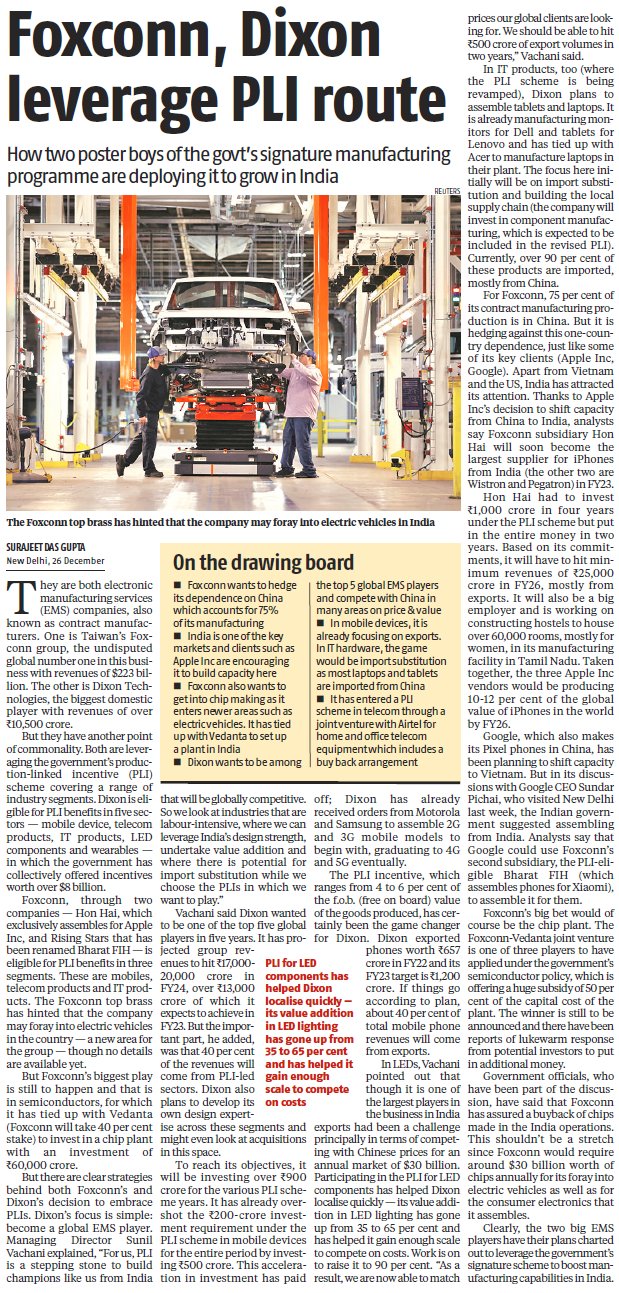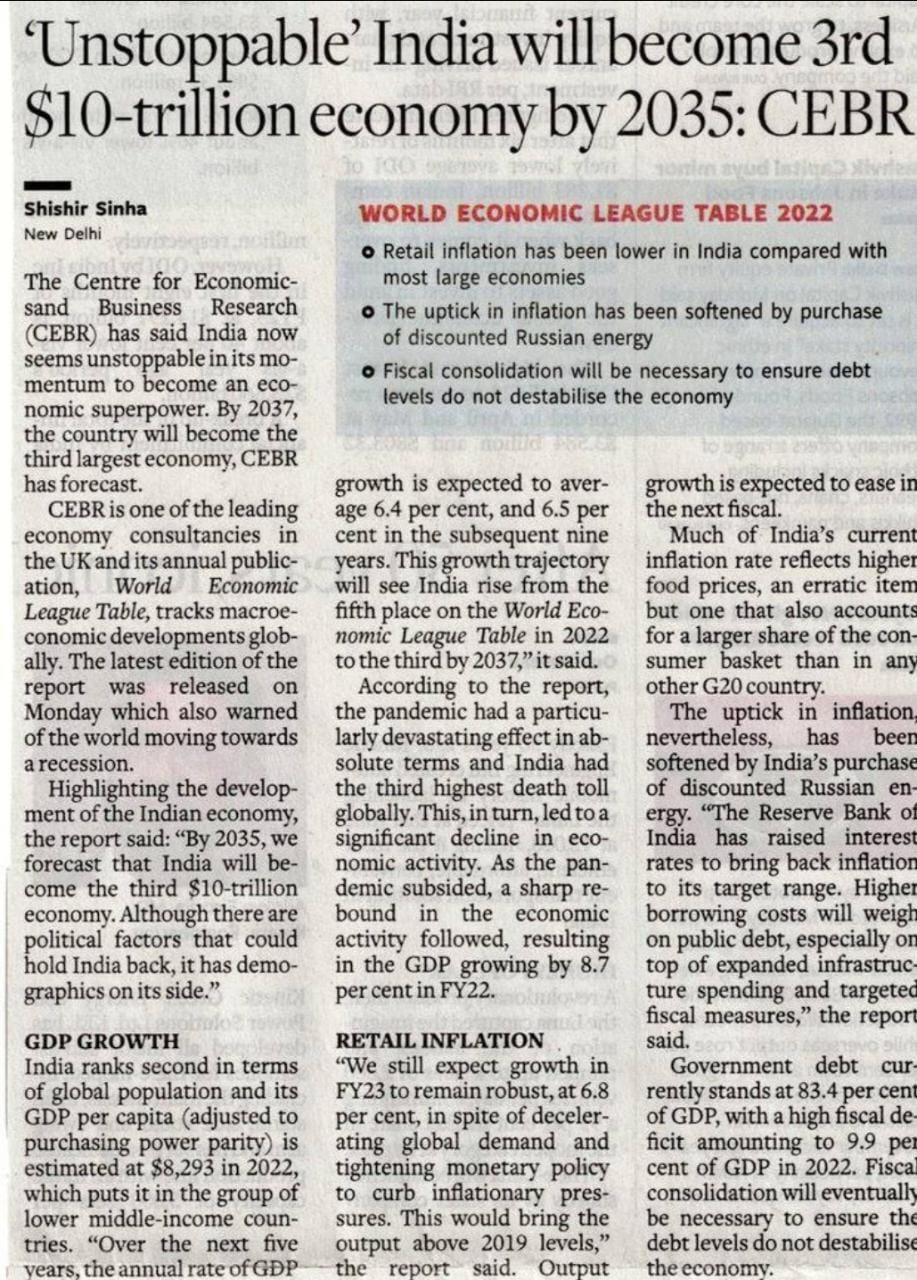Good news, its time to take more jobs from CN. CN will become poor again like before 1979 without investment from EU-US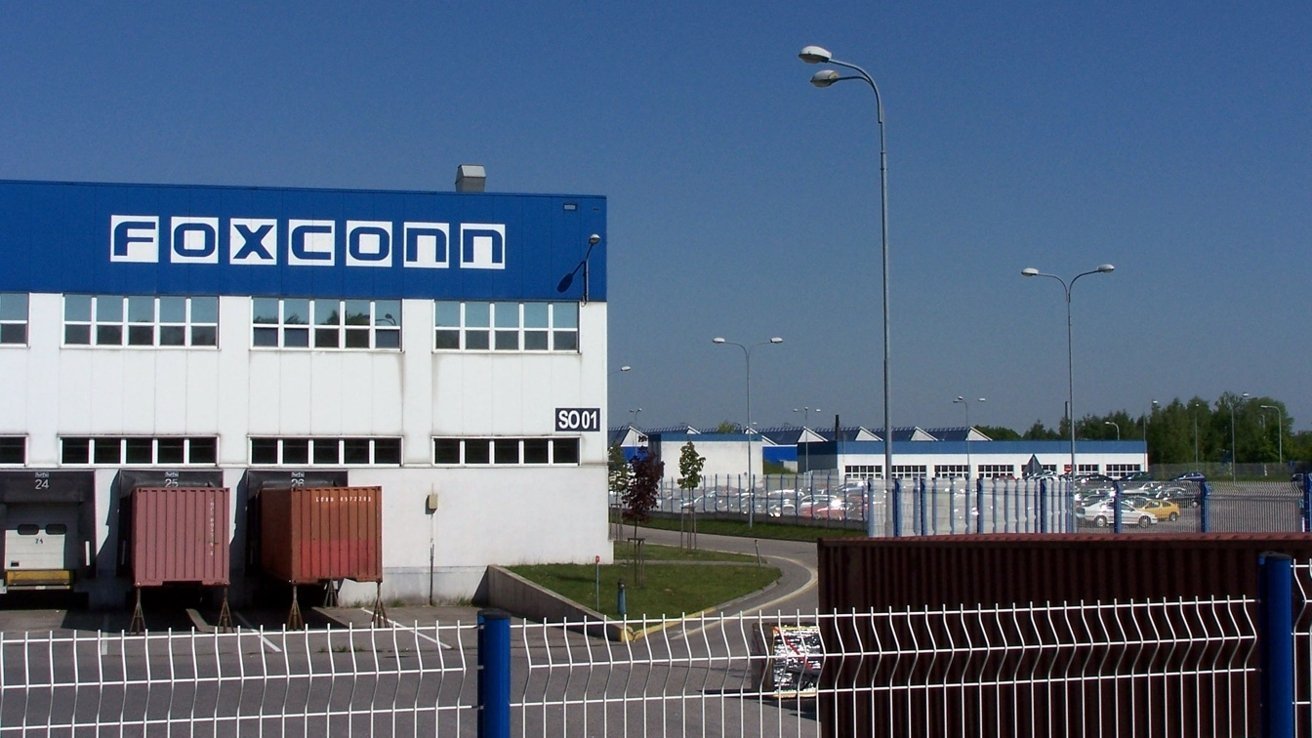
Foxconn to dodge China lockdown, move iPhone production to India | AppleInsider
Analyst Ming-Chi Kuo claims that Foxconn is to step up its iPhone production in India, specifically to overcome delays caused by China's COVID lockdowns.appleinsider.com
@Viva_vietnamm
Latest Thread
- Greece plans to extend territorial waters despite Türkiye’s warning of war
- Takaichi’s Japan Secretly Building Nukes—Chinese Report Claims
- Taiwan defense ministry backs NT$1.25 trillion(US$39.5 billion) special defense budget
- German Startup Drone Maker sucks
- Is Turkiye Israel’s next target in the Middle East?
You are using an out of date browser. It may not display this or other websites correctly.
You should upgrade or use an alternative browser.
You should upgrade or use an alternative browser.
@Iceream , this is large part of why i score India as 3/10 economically, this stuff should have been done 1 - 2 decades ago already.
With its completion and strong impact on production (by logistics costs optimised finally), I can see myself bringing the score to 4 and then 5/10
BTW, I score china around 5/10 only now too....I am tough on marks.

In charts: Why India is all set for an economic boom | India News - Times of India
India News: Thanks to Covid-19, India may have its second tryst with offshoring, says Morgan Stanley research. That’s going to be one of the big drivers of the In
Brother @Nilgiri how true do you think this is ?

In charts: Why India is all set for an economic boom | India News - Times of India
India News: Thanks to Covid-19, India may have its second tryst with offshoring, says Morgan Stanley research. That’s going to be one of the big drivers of the Inm.timesofindia.com
Brother @Nilgiri how true do you think this is ?
There are lot of promising underlying numbers but proof is in the pudding.
TOI prime puts paywall, here is the earlier article from regular TOI:

Explained in charts: Why India is on track to become the world's third-largest economy - The Times of India
India Business News: India will be the world's third-largest economy and stock market before the end of the decade as the country has conditions in place for an economic
anyway here is FT article covering same thing (the morgan stanley report synopsis):

India’s coming decade of outperformance
The country will provide a compelling opportunity in a world starved of growth
Five years after the foundation stone was laid of the ambitious 508-km Mumbai-Ahmedabad bullet train project, work on the 348-km Gujarat stretch of the project has gathered speed, with teams of engineers and workers working 24x7 in shifts to make up for time lost due to land acquisition issues and the pandemic. ThePrint visited five of the state’s project sites a fortnight ago to see what is happening on the ground.
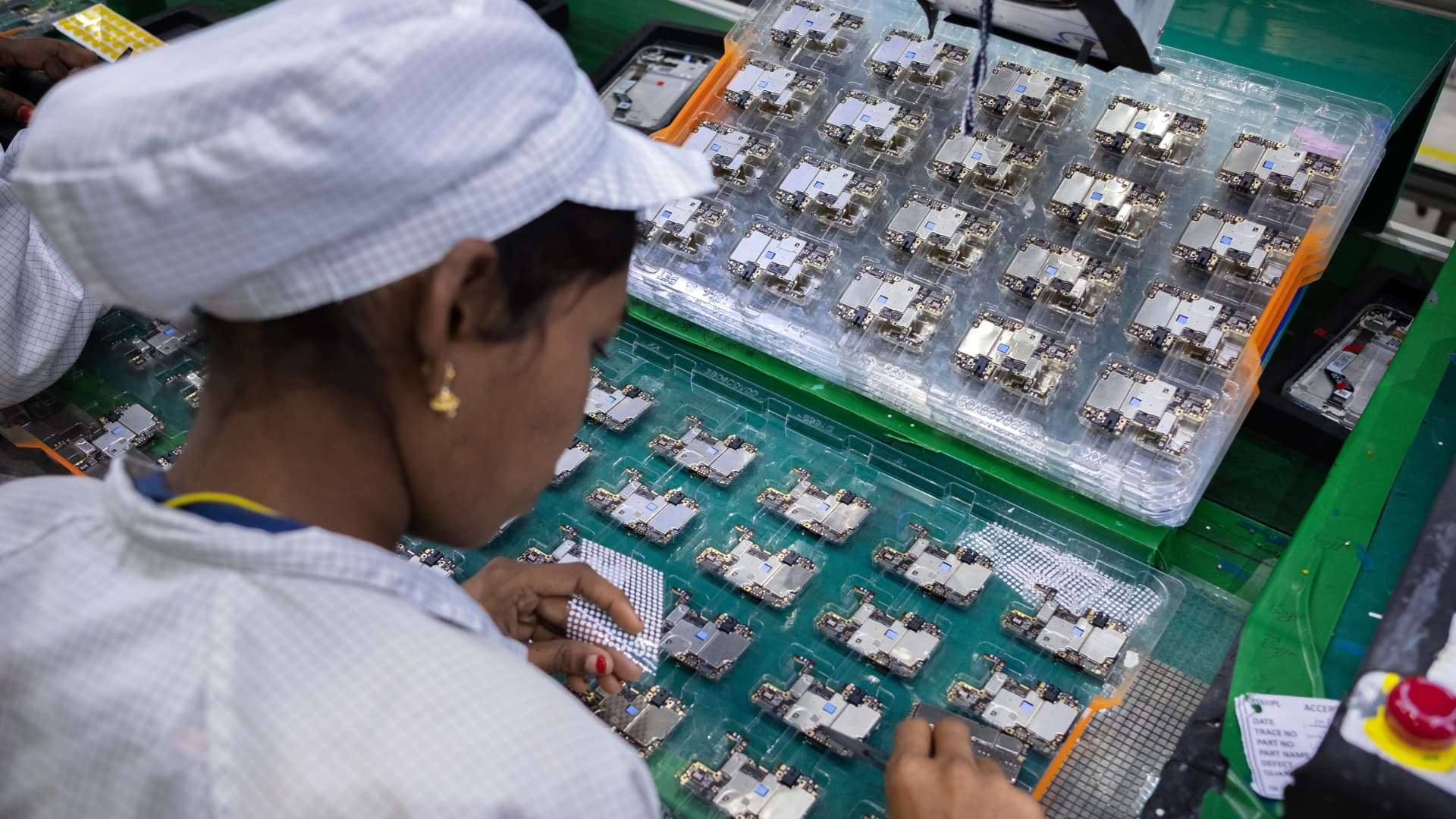
Apple supplier Foxconn plans to quadruple workforce at India plant, sources say
Virus restrictions at its Zhengzhou plant disturbed production and fueled concerns over the impact of China's virus policy on global supply chains.

Embraer Explores Manufacturing Possibilities In India
Talks are on between Embraer and India for a possible partnership.
In its bid to find potential manufacturing partners for its proposed turboprop aircraft, Embraer says it is in active discussion with India and other regions globally. The Brazilian plane maker wants to launch the project soon and would ideally like to see the jet enter into service later this decade.
India in consideration
Embraer is currently searching for a manufacturing partner for its proposed new-generation turboprop, and talks with India are reportedly progressing well. Discussions about the possibility of India featuring in Embraer's larger plan surfaced earlier this year, and the latest reports suggest that the country is still very much in the running.Business Standard quotes the aircraft manufacturer as saying,
It added that the aircraft is still in the development phase, and a decision to launch the project has not been made.“We are in discussions with potential partners in India and globally on a selection of partnering options for the next generation turboprop aircraft — including manufacturing. These discussions are ongoing and progressing well.”
The new turboprop
Embraer predicts the world will need around 11,000 new aircraft with up to 150-seats over the next 20 years. The replacement of aging aircraft will account for 57% of all new deliveries, while 43% will be used to grow markets.The plane maker feels that there will be a trend toward smaller aircraft, driven by an increasing need for flexibility, connectivity, and efficiency. And this is where its new generation turboprop (TPNG) comes into the picture.
Embraer Commercial Aviation president and CEO Arjan Meijer said the new aircraft "is not a turboprop as we know it." It is more of an E-Jet E-2 aircraft with a different form of propulsion rather than an improved turboprop. The TPNG will have the same cabin experience as on the E2, and moving the engines to the rear will mean a much quieter cabin.
Embraer is looking to launch the project sometime in the middle of next year so that the plane could enter service around 2028.
Scope in India
These reports come hot on the heels of the inauguration of the Tata-Airbus C-295 aircraft manufacturing facility in the Indian state of Gujarat on October 30th. Indian Prime Minister Narendra Modi has stated that India could soon be manufacturing large passenger aircraft, suggesting either home-grown designs from scratch or establishing assembly lines for established players like Boeing and Airbus.India is gradually building its portfolio in aerospace technology and manufacturing. There have been some advancements over the years, with manufacturing giants partnering with Indian companies for their products.
State-owned aerospace company Hindustan Aeronautics Limited (HAL) has also taken significant steps, including manufacturing the Hindustan-228, the Indian version of the Dornier-228, and various Indian companies now feature in the global supply chain ecosystem for Airbus and Boeing.

Embraer says talks for manufacturing aircraft in India progressing well
Says it's looking at various partnering options for next-gen turboprop aircraft
Embraer has said its discussions with Indian and global companies for building a new generation turboprop aircraft are progressing well. The Brazilian plane maker, which produces both civil and military jets, has been scouting for partners for its proposed aircraft programme, which could include the manufacture of planes as well.
“We are in discussions with potential partners in India and globally on a selection of partnering options for the next generation turboprop aircraft — including manufacturing. These discussions are ongoing and progressing well,” Embraer has said.
“The next generation turboprop aircraft is in the development phase and a decision to launch the project has not been made,” it added.
Embraer shared this project update in the backdrop of Prime Minister Narendra Modi’s recent remarks on how India could become a manufacturing hub for large passenger aircraft. He made the remarks at the inauguration of the Tata-Airbus C-295 aircraft manufacturing facility in Vadodara on October 30.
Embraer has more than 1,700 commercial jets in service globally. In July, it released a 20-year market outlook, estimating global demand for turboprops could touch 2,280 units. Of this, it said, around 960 units could come from the Asia Pacific region.
The E175 is its most popular aircraft and US airline Sky West is the largest operator of these planes, with 230 jets. In India, Star Air operates five ERJ145 planes and recently signed an agreement to induct two E175 aircraft. At present, there are also 22 Embraer-made business jets in the country.
Airbus did not respond to a query on assembly of planes in India.
“Boeing is in a sweet spot to continue delivering on our commitment to Aatmanirbhar Bharat,” the US plane maker said. “Our business and supply chain teams are constantly evaluating opportunities where India can continue to become a more significant part of Boeing’s global supply chain,” it added.
Boeing’s annually sources around $1 billion worth of aircraft parts from its network of over 300 suppliers in India. It, however, manufactures all its passenger planes in the US. It has a completion centre in China where seats are fitted in planes built and flown from the US. Airbus has aircraft assembly lines in China and the US.
“Aircraft production rates have still not recovered to pre-Covid levels. Manufacturing and assembly would require billions of dollars in investment plus certified and skilled manpower. Then there is the question of market size. Manufacturers will not duplicate facilities unless there is a sound business case,” said an aviation industry veteran.

Apple supplier Foxconn plans to quadruple workforce at India plant, sources say
Virus restrictions at its Zhengzhou plant disturbed production and fueled concerns over the impact of China's virus policy on global supply chains.www.cnbc.com
vedanta: Production at Vedanta-Foxconn semiconductor plant to start within two and half yrs of groundbreaking: Anil Agarwal - The Economic Times
2.5 years left

Estimating Cost to Set Up Semiconductor Fabrication in India? | AIM
Indian government has gone all guns blazing to create a semiconductor ecosystem in India, but how much does it really take to make semiconductor chips?
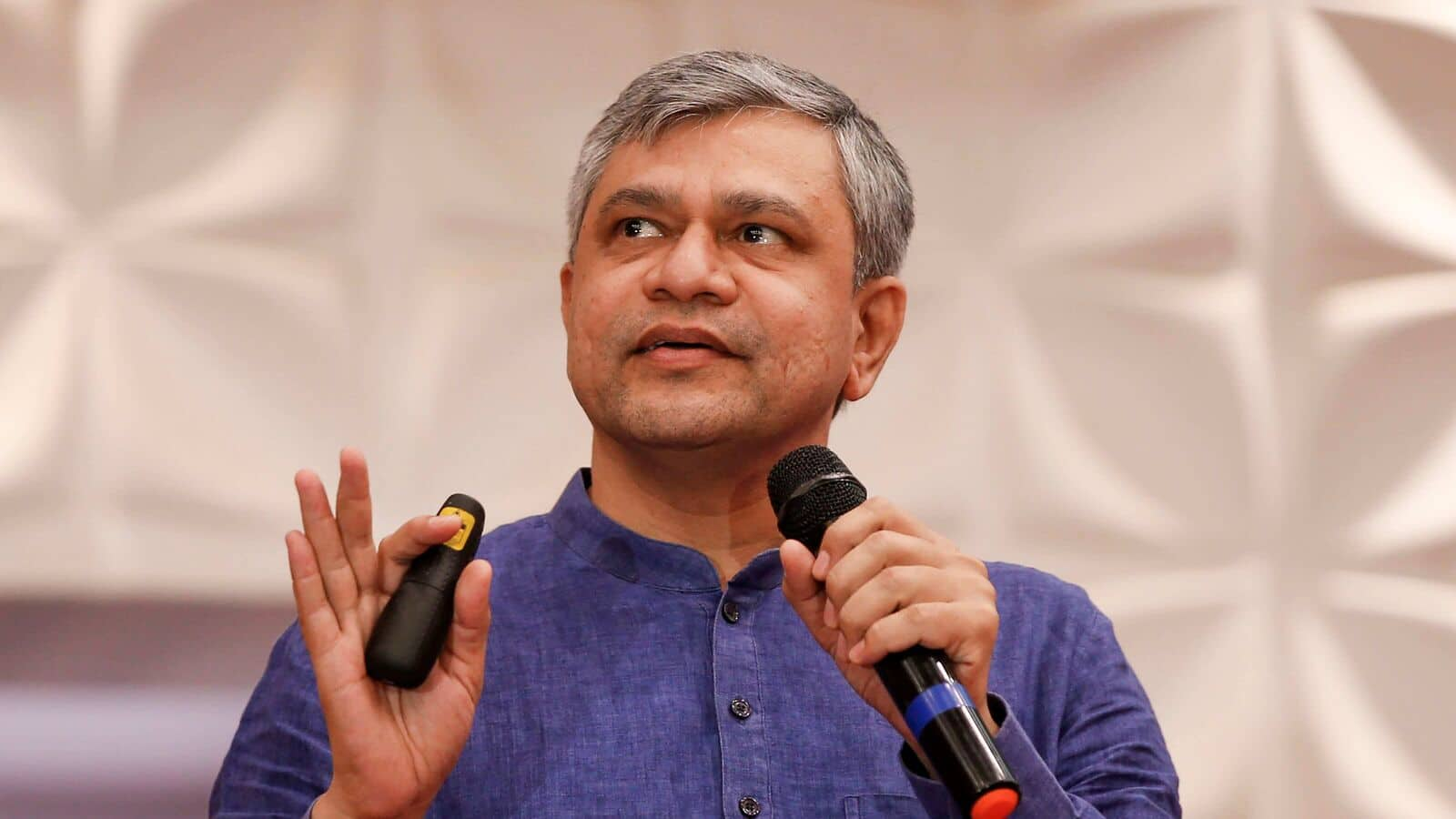
Biggest iPhone manufacturing unit to come up near Bengaluru, to employ 60,000
Telecom and IT Minister Ashwini Vaishnaw on Tuesday said that India is set to get the biggest Apple iPhone manufacturing unit in Hosur in Bengaluru
Telecom and IT Minister Ashwini Vaishnaw on Tuesday said that India is set to get the biggest Apple iPhone manufacturing unit in Hosur in Bengaluru. This comes as Reuters reported that Apple supplier Foxconn is planning to expand their works in India by at least four times by the next two years.
IT minister Ashwini Vaishnaw also informed that the biggest iPhone manufacturing unit would also employ 60,000 people. He further informed that at least 6000 tribal women who are residents near Ranchi and Hazaribagh have been trained for making iPhones.
"Apple's iPhone is now getting made in India and it's the biggest plant in India is being set up at Hosur near Bengaluru. 60,000 people work in a single factory. The first 6,000 employees of these 60,000 employees are our tribal sisters from places nearby Ranchi and Hazaribagh. Tribal sisters have been trained to make Apple iPhone," the minister said.
It is to be noted that Apple had outsourced the making of iPhones in India to Tata Electronics' plant in Hosur. Apple gets iPhones manufactured by electronics giants - Foxconn, Wistron and Pegatron in India.
According to the Reuters report, the Foxconn plan to expand its workforce in India is part of adjustment the company will incur as a result of the disruptions in China owing to their battle with Covid-19.
The Foxconn production unit earlier grabbed headlines when the China's strict Zero Covid policy imposed at its Zhengzhou plant, the world's largest iPhone factory, disturbed production and fueled concerns.
The Reuters report quoted people familiar with the matter and said Taiwan-based Foxconn has plans to boost the workforce at its plant in southern India to 70,000 by adding 53,000 more workers over the next two years.
The Tamil Nadu plant of Foxconn is much smaller than their Zhengzhou unit,
While the size of the plant in India's southern state of Tamil Nadu is dwarfed by Foxconn's Zhengzhou plant, which employs 200,000 workers, it is imminent to Apple Inc.'s efforts to shift majority production away from China.
Foxconn, formally called Hon Hai Precision Industry Co Ltd, opened the India plant in 2019 and has been ramping up production. It began producing iPhone 14 this year.
Currently, iPhones are assembled in India by at least three of Apple's global suppliers: Foxconn and Pegatron in Tamil Nadu; and Wistron in nearby Karnataka state.

Biggest iPhone manufacturing unit to come up near Bengaluru, to employ 60,000
Telecom and IT Minister Ashwini Vaishnaw on Tuesday said that India is set to get the biggest Apple iPhone manufacturing unit in Hosur in Bengaluruwww.livemint.com
Telecom and IT Minister Ashwini Vaishnaw on Tuesday said that India is set to get the biggest Apple iPhone manufacturing unit in Hosur in Bengaluru. This comes as Reuters reported that Apple supplier Foxconn is planning to expand their works in India by at least four times by the next two years.
IT minister Ashwini Vaishnaw also informed that the biggest iPhone manufacturing unit would also employ 60,000 people. He further informed that at least 6000 tribal women who are residents near Ranchi and Hazaribagh have been trained for making iPhones.
"Apple's iPhone is now getting made in India and it's the biggest plant in India is being set up at Hosur near Bengaluru. 60,000 people work in a single factory. The first 6,000 employees of these 60,000 employees are our tribal sisters from places nearby Ranchi and Hazaribagh. Tribal sisters have been trained to make Apple iPhone," the minister said.
It is to be noted that Apple had outsourced the making of iPhones in India to Tata Electronics' plant in Hosur. Apple gets iPhones manufactured by electronics giants - Foxconn, Wistron and Pegatron in India.
According to the Reuters report, the Foxconn plan to expand its workforce in India is part of adjustment the company will incur as a result of the disruptions in China owing to their battle with Covid-19.
The Foxconn production unit earlier grabbed headlines when the China's strict Zero Covid policy imposed at its Zhengzhou plant, the world's largest iPhone factory, disturbed production and fueled concerns.
The Reuters report quoted people familiar with the matter and said Taiwan-based Foxconn has plans to boost the workforce at its plant in southern India to 70,000 by adding 53,000 more workers over the next two years.
The Tamil Nadu plant of Foxconn is much smaller than their Zhengzhou unit,
While the size of the plant in India's southern state of Tamil Nadu is dwarfed by Foxconn's Zhengzhou plant, which employs 200,000 workers, it is imminent to Apple Inc.'s efforts to shift majority production away from China.
Foxconn, formally called Hon Hai Precision Industry Co Ltd, opened the India plant in 2019 and has been ramping up production. It began producing iPhone 14 this year.
Currently, iPhones are assembled in India by at least three of Apple's global suppliers: Foxconn and Pegatron in Tamil Nadu; and Wistron in nearby Karnataka state.

ISMC consortium to be first to start work on chip foundry in India
The International Semiconductor Consortium’s (ISMC’s) proposed $3 billion chip fab in Mysuru is likely to start construction as early as...

India set to export mobile phones worth US$ 9 bn in FY23 - IndBiz | Economic Diplomacy Division
India is expected to export mobile phones amounting to US$ ...
 indbiz.gov.in
indbiz.gov.in
- In FY22, the exports of mobiles reached US$ 5.8 billion
- Electronics worth about US$ 87 billion were manufactured domestically in 2021
- Exports of mobile phones in India have crossed the US$ 5 billion mark in the April-October period of FY23
- About 66% of foreign direct investment (FDI) in electronics has arrived in the last three years
India is expected to export mobile phones amounting to US$ 9 billion in FY23, up from US$ 5.8 billion in FY22, as production and outward shipments are being increased by the manufacturers, according to a report from industry body India Cellular and Electronics Association (ICEA).
According to the report, electronics worth about US$ 87 billion were manufactured domestically in 2021, which is expected to reach US$ 100 billion this year. Additionally, the country is expected to achieve an overall electronics manufacturing of US$ 300 billion by FY26.
Exports of mobile phones in India have crossed the US$ 5 billion mark in the April-October period of FY23, compared to US$ 2.2 in the same period last year. Due to the introduction of Production-Linked Incentive (PLI) schemes, an ecosystem for manufacturing electronics has been developed, and growth in exports has been witnessed. According to media reports, the INR 41,000-crore PLI scheme for smartphone manufacturing commenced in 2020, where Tamil Nadu has emerged as a strong player in attracting companies such as Foxconn and Pegatron, the contract manufacturers for Apple, apart from Dell and Bharat FIH (another Foxconn unit).
Experts said that the country plans to increase mobile phone exports from the current US$ 18-20 billion to US$ 120 billion by FY26. Mobile phones could account for US$ 60 billion, in the US$ 120 billion electronics exports targeted by FY26. Additionally, according to media reports, the export of electronics goods in the April-September period increased by 54% to US$ 10.2 billion from US$ 6.5 billion in the same period last year.
India is expected to become an electronics manufacturing hub, as all the states are willing to participate in the electronics manufacturing opportunity, which is creating hundreds of thousands of jobs across the country. About 66% of foreign direct investment (FDI) in electronics has arrived in the last three years. Mobile phones have become the single largest contributor to electronics exports.
With increasing salaries, and consumer electronic companies launching more affordable products, the shipments of electronics and smartphones can be expected to witness a further increase.

Exclusive: Air India nears historic order for up to 500 jets
Such a deal could top $100 billion dollars at list prices, including any options, and rank among the biggest by a single airline in volume terms following an American Airlines order over a decade ago.
PARIS/NEW DELHI, Dec 11 (Reuters) - Air India is close to placing landmark orders for as many as 500 jetliners worth tens of billions of dollars from both Airbus and Boeing as it carves out an ambitious renaissance under the Tata Group conglomerate, industry sources said on Sunday.
The orders include as many as 400 narrow-body jets and 100 or more wide-bodies, including dozens of Airbus A350s and Boeing 787s and 777s, they said, speaking on condition of anonymity as finishing touches are placed on the mammoth deal in coming days.
Such a deal could top $100 billion dollars at list prices, including any options, and rank among the biggest by a single airline in volume terms, overshadowing a combined order for 460 Airbus and Boeing jets from American Airlines over a decade ago.
Even after significant expected discounts, the deal would be worth tens of billions of dollars and cap a volatile year for plane giants whose jets are again in demand after the pandemic, but who face mounting industrial and environmental pressures.
It would also allow Airbus to secure a home for some A350 production slots initially earmarked for Russia's Aeroflot and now left open because of war-related sanctions against Moscow.
Airbus (AIR.PA) and Boeing declined to comment. Tata Group-owned Air India did not respond to a request for comment.
China last week delivered its first C919 jetliner but is at least a decade away from competing on such a scale, experts say.
The potential blockbuster order comes days after Tata announced the merger of Air India with Vistara, a joint-venture with Singapore Airlines, to create a bigger full-service carrier and strengthen its presence in domestic and international skies.
That deal gives Tata a fleet of 218 aircraft, cementing Air India as the country's largest international carrier and second largest in the domestic market after leader IndiGo (INGL.NS)
Buying debt-ridden Air India has also given Tata access to valuable flying rights and landing slots, especially to destinations in the United States and Europe.
HURDLES TO GROWTH
Air India's maharajah mascot was once synonymous with lavishly decorated planes and stellar service but its reputation declined in the mid-2000s as financial troubles mounted.Founded by JRD Tata in 1932, Air India was nationalised in 1953. Tata regained control in January and has since been working to revive its reputation as a world-class airline.
The order reflects a strategy to re-capture a solid share of trips between India's large overseas diaspora and cities such as Delhi and Mumbai, dominated by foreign rivals such as Emirates.
Air India also wants to win a bigger share of regional international traffic and the domestic market, setting up a battle on both fronts with IndiGo.
Delivered over the next decade, the 500 jets would replace and expand fleets in the world's fastest-growing air travel market, while contributing to Prime Minister Narendra Modi's goal of expanding the economy to $5 trillion.
But experts warn many hurdles stand in the way of Air India's ambition to recover a strong global position, including frail domestic infrastructure, pilot shortages and the threat of tough competition with established Gulf and other carriers.
It may also struggle to get the medium-haul Airbus A321neos being ordered for the Air India-Vistara tie-up as quickly as it would like, with the European planemaker sold out until 2028 or beyond.
One industry source said new Boeing 737 MAXs will most likely go to Air India Express, the company's budget operator which could be renamed.
Insiders say plane and engine makers have been clamouring at Air India's door for months, with new Chief Executive Campbell Wilson refusing to rush the make-or-break fleet decision.
Reuters reported in July that Air India was taking more time to study Airbus A350s and Boeing wide-body 787 and 777 models, on top of a probable mixed order for smaller single-aisle jets.
Last month, Campbell confirmed talks to "greatly expand" Air India's fleet over the next five years and said, "At the risk of gross understatement, the investment will be substantial."
Rajendra Chola
Well-known member

Exclusive: Air India nears historic order for up to 500 jets
Such a deal could top $100 billion dollars at list prices, including any options, and rank among the biggest by a single airline in volume terms following an American Airlines order over a decade ago.www.reuters.com
PARIS/NEW DELHI, Dec 11 (Reuters) - Air India is close to placing landmark orders for as many as 500 jetliners worth tens of billions of dollars from both Airbus and Boeing as it carves out an ambitious renaissance under the Tata Group conglomerate, industry sources said on Sunday.
The orders include as many as 400 narrow-body jets and 100 or more wide-bodies, including dozens of Airbus A350s and Boeing 787s and 777s, they said, speaking on condition of anonymity as finishing touches are placed on the mammoth deal in coming days.
Such a deal could top $100 billion dollars at list prices, including any options, and rank among the biggest by a single airline in volume terms, overshadowing a combined order for 460 Airbus and Boeing jets from American Airlines over a decade ago.
Even after significant expected discounts, the deal would be worth tens of billions of dollars and cap a volatile year for plane giants whose jets are again in demand after the pandemic, but who face mounting industrial and environmental pressures.
It would also allow Airbus to secure a home for some A350 production slots initially earmarked for Russia's Aeroflot and now left open because of war-related sanctions against Moscow.
Airbus (AIR.PA) and Boeing declined to comment. Tata Group-owned Air India did not respond to a request for comment.
China last week delivered its first C919 jetliner but is at least a decade away from competing on such a scale, experts say.
The potential blockbuster order comes days after Tata announced the merger of Air India with Vistara, a joint-venture with Singapore Airlines, to create a bigger full-service carrier and strengthen its presence in domestic and international skies.
That deal gives Tata a fleet of 218 aircraft, cementing Air India as the country's largest international carrier and second largest in the domestic market after leader IndiGo (INGL.NS)
Buying debt-ridden Air India has also given Tata access to valuable flying rights and landing slots, especially to destinations in the United States and Europe.
HURDLES TO GROWTH
Air India's maharajah mascot was once synonymous with lavishly decorated planes and stellar service but its reputation declined in the mid-2000s as financial troubles mounted.
Founded by JRD Tata in 1932, Air India was nationalised in 1953. Tata regained control in January and has since been working to revive its reputation as a world-class airline.
The order reflects a strategy to re-capture a solid share of trips between India's large overseas diaspora and cities such as Delhi and Mumbai, dominated by foreign rivals such as Emirates.
Air India also wants to win a bigger share of regional international traffic and the domestic market, setting up a battle on both fronts with IndiGo.
Delivered over the next decade, the 500 jets would replace and expand fleets in the world's fastest-growing air travel market, while contributing to Prime Minister Narendra Modi's goal of expanding the economy to $5 trillion.
But experts warn many hurdles stand in the way of Air India's ambition to recover a strong global position, including frail domestic infrastructure, pilot shortages and the threat of tough competition with established Gulf and other carriers.
It may also struggle to get the medium-haul Airbus A321neos being ordered for the Air India-Vistara tie-up as quickly as it would like, with the European planemaker sold out until 2028 or beyond.
One industry source said new Boeing 737 MAXs will most likely go to Air India Express, the company's budget operator which could be renamed.
Insiders say plane and engine makers have been clamouring at Air India's door for months, with new Chief Executive Campbell Wilson refusing to rush the make-or-break fleet decision.
Reuters reported in July that Air India was taking more time to study Airbus A350s and Boeing wide-body 787 and 777 models, on top of a probable mixed order for smaller single-aisle jets.
Last month, Campbell confirmed talks to "greatly expand" Air India's fleet over the next five years and said, "At the risk of gross understatement, the investment will be substantial."
Tata could hopefully use the Gujarat plant and leverage it’s advantages with Airbus to start A320 manufacturing in India and exports from India. Could be an game changer.

Good News For India, Vietnam As Apple Suppliers Accelerate Buildup Outside China: Analysts
India and Vietnam are emerging as Apple Inc.’s next manufacturing hubs as assembly partners seek to add resilience to a supply chain heavily centered on China.

India, Vietnam are emerging as Apple's next manufacturing hub, analysts say - Times of India
India Business News: “Led by Foxconn and Pegatron, companies have already invested in factories, production lines, relatively advanced manufacturing processes, and personn
India and Vietnam are emerging as Apple Inc's next manufacturing hubs as assembly partners seek to add resilience to a supply chain heavily centered on China and shaken by its geopolitical and health challenges.
Key electronics manufacturers are moving faster to diversify their capacity globally, taking advantage of local incentive policies, according to Counterpoint Research analysts Ivan Lam and Shenghao Bai. The multiyear effort, which began before Covid-19 and economically stifling lockdowns roiled China, may see leading partner Hon Hai Precision Industry Co move as much as 30% of its capacity to those Asian nations and Brazil, they said.
They caution that a direct replacement for China isn’t immediately in the cards, however firms like Hon Hai, also known as Foxconn, and fellow Taiwanese assembler Pegatron Corp. are putting the foundations in place to handle more of the final assembly and packaging of products outside China.
“Led by Foxconn and Pegatron, companies have already invested in factories, production lines, relatively advanced manufacturing processes, and personnel training in India,” they wrote. The country’s vast population and high birth rate make it an attractive market for end-products as well as a manufacturing base, while Vietnam’s workforce offers lower labor costs than in China. Vietnam has attracted 21 Apple suppliers to operate in the country, according to the report, though it lacks the ability to produce the all-important iPhone handset.
According to Counterpoint’s research, smartphones manufactured in India grew 16% in the second quarter of this year, reaching more than 44 million units.
China, for its part, has seen its workforce shrinking since 2020, according to data from the World Bank. A legion of skilled workers who’d received some education and training has been the backbone of China’s rise as the world’s factory.
Apple has done its part to reduce reliance on individual factories or skilled labor by making its iPhone product design more modular and transferable across facilities, Counterpoint said. The company has put a focus on ease of maintenance and deployment of new product assembly.
Manufacturing difficulty was reduced significantly with the iPhone 14 and iPhone 14 Plus models, according to the analysts. “Now it is possible for the plants in India to produce the iPhone 14 almost simultaneously with the plants in China,” they wrote. Apple did begin iPhone production in India much faster this year than with prior generations.
Tata Group's Big Leap In The Semiconductor Industry
The salt-to-steel conglomerate intends to invest US$90 billion (about ₹ 7,452 billion) in the semiconductor industry across the group companies over the next five years. It plans to foray into advanced chip manufacturing, popularly known as fabs, in a few years.
N Chandrasekaran also mentioned the possibility of partnering with existing chip manufacturers and eventually launching an upstream chip fabrication platform.
The upstream process of wafer fabrication is more challenging both technologically and financially than the downstream steps of assembly and testing.
Also, this isn't the first move by the group in this industry. Earlier in June 2022, Tata group companies – Tata Motors and Tejas Networks entered a strategic partnership with Japanese semiconductor manufacturer Renesas Electronics Corporation.
The tie-up will help Tata Motors tide over the global auto chips crunch that has affected its earnings and resulted in production cuts and even temporary plant shutdowns. According to the India Electronics and Semiconductor Association, India's semiconductor market is expected to more than double between 2021 to 2026 and reach US$ 64 billion (bn).
(More at link)
==============================
560,960 views Dec 9, 2022 #Tata #Chips
India starts investing in the global semiconductor market. India's Tata Group will begin producing semiconductors in the country within a few years, a move that the chairman of the group's main company said will make the South Asian country a key part of global chip supply chains. Tata Sons Chairman Natarajan Chandrasekaran revealed that the conglomerate plans to launch new businesses in emerging fields such as electric vehicles.

India overtakes China in late stage funding; closing in on early, growth stages: Elevation Capital - BusinessToday
With ample global liquidity and a riskier outlook on China, India is becoming a lucrative investment for global venture capitalists. In the last four quarters (Q4’21 to Q3’22), venture capital investors infused a total of $32 billion across stages into Indian start-ups in comparison to $31...
India is emerging as a primary beneficiary of China’s crackdown on new-age tech with the value of the venture capital investments in the country surpassing or nearly matching its neighbour across stages. In terms of absolute funding, India overtook China in late-stage funding in 2021 and is beginning to surpass China in the early and growth stages, as per a report by venture capital firm Elevation Capital.
“India is leveraging an interesting dichotomy playing out between the US and China. In the first half of the decade, China took market share from the US, and India remained constant. In the second half of the decade, with China’s percentage of global funding dropping, the US took back the market share and the market share for India increased as well,” the report said.
With ample global liquidity and a riskier outlook on China, India is becoming a lucrative investment for global venture capitalists. In the last four quarters (Q4’21 to Q3’22), venture capital investors infused a total of $32 billion across stages into Indian start-ups in comparison to $31 billion in China. The decline (in China) was primarily driven by late-stage funding drying up in the country, which dropped as much as 82 per cent in the first two quarters of 2022 as against 50 per cent in India. As per the report, companies such as Byte Dance and Shein are trading at significant discounts to their previous valuations while average investment cheque size has also witnessed a drop across all funding stages.
On a year-on-year basis, India increased its market share from 2016-2021 by more than 2.5x. India’s share of late-stage funding globally has increased to approximately 10.5 per cent in 2022 from 5.7 per cent in 2019.
In early-stage investments, while the US has seen a 44 per cent decline from Q2-21 to Q2-22, India and China have remained relatively stable. General sentiment on India’s early-stage ecosystem continues to remain bullish.
In 2021, for the first time, India outpaced China in new unicorn creation with 47 companies achieving $1 billion valuation or above against 42 unicorns in China. India has seen emergence of 21 new unicorns so far in 2022 while the China number stands at 7. At the current rate, India is on a path to outpace China by 2024/2025 in global unicorn share.
A total of $120 billion was invested in India in the last 10 years, 50 per cent which was just in the last 2.5 years. While the average 2-year funding was in the range of $1.6 billion at the beginning of the decade, it has reached an average of $26 billion in the last 2 years.
The report predicts that India is strongly positioned to navigate this downturn compared to its peers with inflation at a lower rate than many peers in the G-20 (7 per cent in India as compared to 81 per cent in Argentina, 10 per cent in UK and 8.3 per cent in US as of Nov 30, 2022) and with Indian rupee outperformed most peers by high forex reserves.




